
PORT-AU-PRINCE — Two teenage boys in Haiti have advanced forms of cancer. Both cancers have a high survival rate when the disease is caught early and treated aggressively. Neither boy can be treated at the country’s only hospital dedicated to pediatric cancer — one because he is too old, the other because his cancer is too complicated for the doctors.
But that’s where their stories diverge.
One boy, 14, through a stroke of luck, finds help through a charity that flies him and his mother to Miami for state-of-the-art treatment.
And the other? He remains in Haiti, a 17-year-old struggling to get treatment in a broken healthcare system with poorly trained doctors, limited chemotherapy options and treatment that is many hours away on a public bus. In a country where there are only 10 pediatric hospital beds devoted to cancer — and those who have the disease often are shunned — his case illustrates how the poor and powerless pay the price for the reluctance of Haiti’s leaders to invest in their medical system.
PRAYING FOR A MIRACLE
“Oh God, oh God.”
Sherry Burnette couldn’t stop herself from exclaiming the words when she first saw the boy with his right eye bulging nearly out of its socket.
The boy — a gangly 14-year-old named Djonsly Alcin — had stepped into a room inside Burnette’s Love A Child charity clinic in Fond-Parisien near Haiti’s border with the Dominican Republic. He’d gone to the clinic after he and his mother, Marie Belatrice Louis-Jean, had been to a half dozen other places, including the biggest public hospital, seeking help for the tumor that was slowly pushing his eye out of place and blinding him.
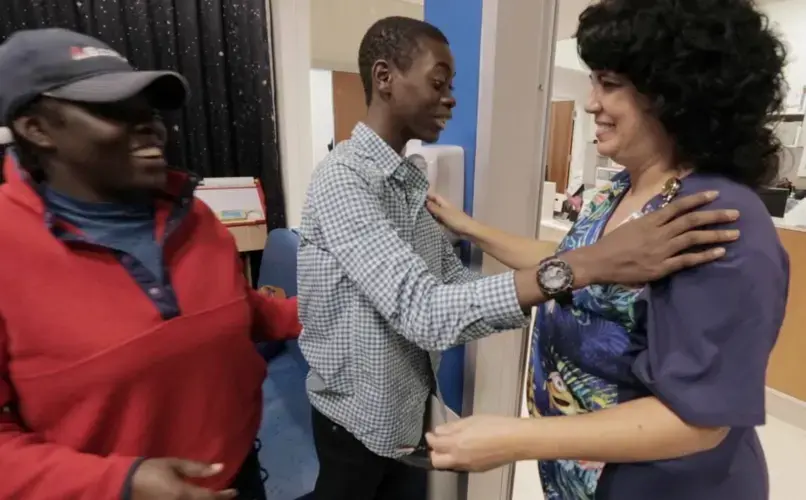
No one in any of the medical facilities that offer care to the poor had been able to help, the boy’s mother told Burnette. One had advised them to pray for a miracle. Another had offered only eye drops.
“They weren’t able to do anything,” Louis-Jean, 37, said. “If they had done something, the eye would have never reached this exaggerated stage.”
It was only by chance that Djonsly (pronounced Jons-lee) and his mother had heard about the clinic. On the streets of Port-au-Prince, Louis-Jean had mentioned her increasingly desperate search for help to a stranger. The stranger, a woman, told her about a charity clinic. It was a two-hour trek, she warned, requiring two bus trips and a motorcycle taxi.
Louis-Jean didn’t hesitate. Three days after the conversation, she and her son headed for the clinic, leaving at 3 a.m. and arriving two hours later to a long line of desperately sick people.
But they didn’t have long to wait. As soon as the staff saw Djonsly’s eye, they rushed him in for a consultation — and then to Burnette, founder of the Fort Myers-based nonprofit, to see how she could help. She took a photo and sent Djonsly for tests.
“That’s when the tumor was discovered,” she told the Miami Herald. “No one in Haiti could do anything about it.”
Burnette had an idea. She fired off an email to Calvin Babcock, a businessman who runs his own charity in Haiti, Living Hope Haiti Christian Mission. He’s also the chairman of the board of Baptist Hospital in Miami.
“Do you think there is any possibility of getting donated care for him at the hospital?” Burnette asked.
Babcock, who gets at least one request a week for help in Haiti through his charity, thought it was likely that the tumor was benign. He agreed to help.
“Every other day I get a request from Whatsapp, on Facebook, from some place, on how we can help this patient — who, in America, would have had their cancer problem taken care of five, 10 or 15 years ago and now it has progressed to a grotesque state,” he said. “There’s very, very little healthcare for the poor in Haiti, and when I say that I mean, there are people who pass away every day in Haiti from conditions that would be easily treated in America.”
Djonsly’s fortunes were changing. On Feb. 10, four months after he first met Burnette, he and his mother flew to Miami to see if he could get treatment. The tests at Baptist Health South Florida revealed that Djonsly had optic pathway glioma, a slow-growing brain tumor that originated in the nerve of the eye, connecting it to the brain.
“They told me if I had stayed another month or two with this undiagnosed, I could have lost my life,” Djonsly said. “I would have already been dead.”
Djonsly told his oncologist, Dr. Doured Daghistani, that the swelling in his eye and abnormal vision had started at least two years earlier.
Daghistani, the medical director of pediatric oncology at Baptist Health’s Miami Cancer Institute, said cancer in the brain is the second most common cancer in children after acute leukemia and before lymphoma, but optic pathway glioma, he said, is rare.
“He came at stage 4,” Daghistani said. “He had metastasized all the way down in his spine.”
Had he been in the U.S., Djonsly likely would have been examined and given an MRI as soon as his vision began to blur two years earlier. The cancer probably would have been found before his vision was lost. The early diagnosis, before the disease had spread, and access to other treatment options in the U.S. would have given him the best chance of a cure.
But Djonsly’s cancer was advanced. He needed chemotherapy and two surgeries, one to place his eye back where it belonged and the other, a 10-hour operation to “debulk” the disease in his brain by removing as much of the mass as possible without neurological damage. An MRI machine would be in the operating room to give doctors a view of what they were doing — a simple enough thing in the U.S., but a near-impossibility if the procedure had been attempted in Haiti, which has only one MRI machine in the whole country.
Djonsly knew that the operations — even though they offered him a much better chance than anything he could have found in Haiti — were risky.
“I was afraid of dying,” he said. “They told me that I could end up disabled... They even told me that I could end up losing the other eye. I was thinking about this all of the time. I am still young — and I end up losing both my eyes?”
‘GOD IS GUIDING MY STEPS’
As Djonsly recuperated from his surgeries in Miami, 700 miles to the south in Haiti, the other boy — 17-year-old Djooly Jeune — had finally gotten in to a charity called Double Harvest, where a clinic at the time was being staffed by a visiting team of foreign doctors.
The oldest of five children, Djooly (pronounced Joo-lee) first became sick in August 2017, four months after his father died of a stroke. The teenager’s left ear had started throbbing, he told his mother. Angena Altidor thought it was a simple earache. She bought some over-the-counter drops. But he got worse.
“This side started swelling up,” Altidor, 51, said as she pointed to the left side of her jaw.
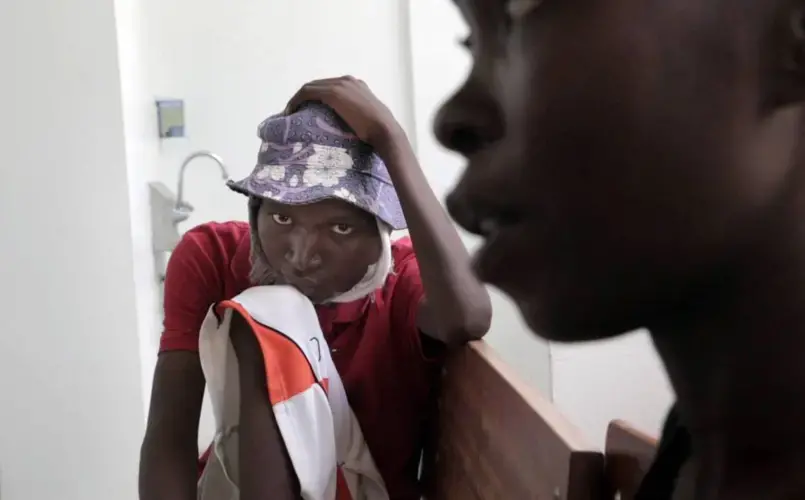
Sitting on a borrowed chair in her one-room home in Croix-des-Bouquets, on the northeastern edge of Port-au-Prince, she described the gradual distortion of her son’s face as the problem worsened and he became more withdrawn.
“His face was so swollen,” she said, “that he couldn’t breathe and his mouth couldn’t close.”
At Double Harvest, a doctor removed some tissue from the side of Djooly’s face in a crude attempt to help.
“They sliced him,” Altidor said.
But they didn’t send the tissue to a lab for a biopsy, she said. Six months into the search to find out what was wrong with her son, Altidor was no closer to an answer.
Two weeks later, Djooly’s face was still swollen, he was in excruciating pain and the bandage had begun to ooze and smell. Altidor said she tried to get workers at a hospital near her home to change the bandage — it was supposed to be changed every day — but they refused.
She heard there were different doctors at Double Harvest, and went back. This time, she and her son found a surgical team from Baptist Health, an effort organized — coincidentally — by Babcock’s charity.
Martha Pearson, a Baptist nurse who is Haitian American, remembered her shock when she saw Djooly, his jaw so swollen he could no longer chew food and his body emaciated from a lack of nutrition. He tried to hide his bulging face when anyone looked at him.
“He had a tumor almost the size of a grapefruit,” Pearson said. “He was not eating, just able to drink.”
She got him new bandages and antibiotics. Then she turned to Babcock for more help. He arranged for Djooly to get a baseline CT scan at Bernard Mevs, a private nonprofit hospital in the capital. After that, through people she knew, Pearson said she got Djooly admitted into the cancer clinic at the University Hospital of Mirebalais, one of the few medical facilities that treat Haiti’s poor for free.
At about the same time, Dr. Roger Mixter, a volunteer plastic surgeon from Wisconsin who had consulted on the case, was trying to get Djooly an appointment in the country’s only childhood cancer center, located at St. Damien Pediatric Hospital in Port-au-Prince, even though, at 17, he was three years older than the cutoff age of 14.
By then, the timid teen had been to five different hospitals and seen an equal number of dentists or doctors. They’d prescribed everything from teeth cleanings to pain medication. None had considered the possibility that the large mass distorting his face could be a cancerous tumor — until he reached Mirebalais.
Finally, Djooly and his mother got an answer: A biopsy showed he had Burkitt’s lymphoma, a rare and aggressive form of non-Hodgkin’s lymphoma. In children in the U.S., Burkitt’s lymphoma has a high long-term survival rate — 80 to 90 percent. But that requires prompt and aggressive chemotherapy.
By the time the disease was diagnosed in Djooly, he had been feeling the symptoms of the fast-growing cancer for at least eight months.
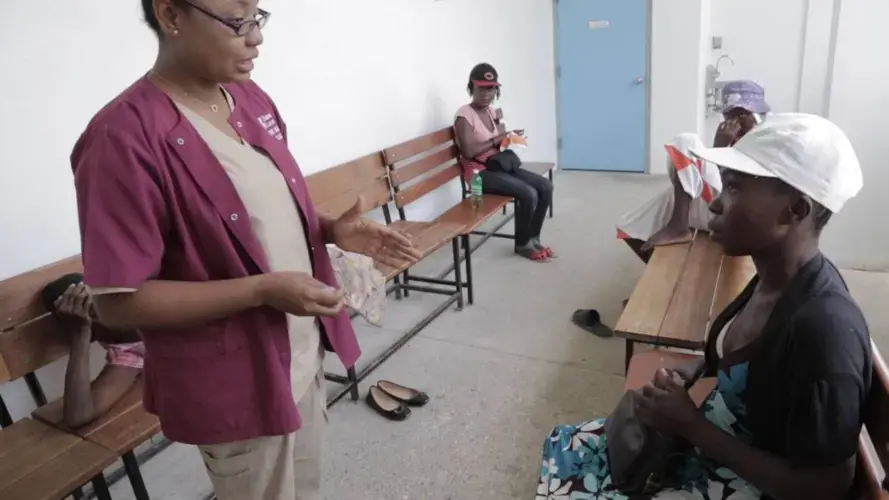
There is a popular Creole proverb rooted in the days before Haiti became the first free black nation. When French plantation owners wanted to punish disobedient slaves, they forced them to carry 50-pound weights on their heads while both hands and feet were shackled.
“Chay la vinn pi lou pase yon pwa senkant.” Or, in English, “My problems are so overwhelming, they weigh more than 50 pounds.”
That’s how Djooly’s mother said she feels most days.
“If you see me walking, it is God who is guiding my steps,” Altidor said. “There are times I’m walking ... and I’ll pass you and don’t even see you. What am I thinking about? I am thinking about Djooly’s illness, how badly he’s sick, and with the cancer, because they say it can’t be treated.”
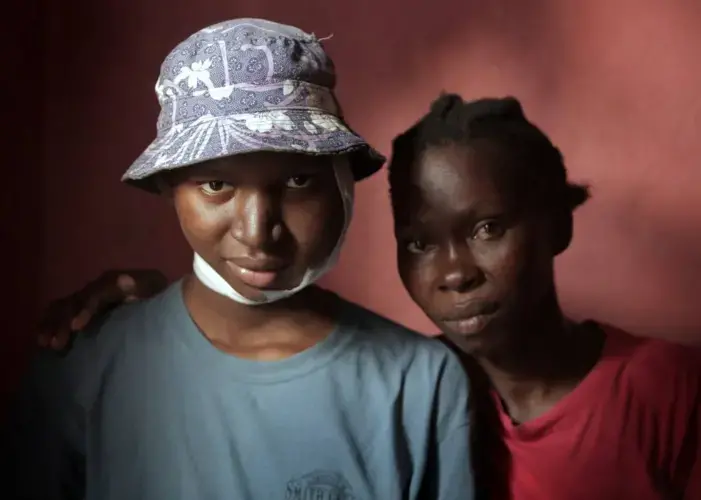
Doctors have told Altidor they cannot offer her any guarantees about the future and even if Djooly responds well to chemo, there is a high chance of recurrence.
“If it comes back, we don’t have any treatment for him,” said Dr. Ruth Damuse, the oncology program director at the Mirebalais hospital. “We know that there is something that can be done. We just don’t have it.”
‘CANCER IS FAR BEHIND’
In Haiti, where Djooly is being treated, the government doesn’t keep records on survival rates for childhood cancer, but pediatric oncologists say, in general, the cure rate in low-resource countries is about 20 percent.
The prognosis for the other teen, Djonsly — despite his complicated and advanced case — is more hopeful, simply because he’s being treated in the U.S., where there’s access to different drugs and the five-year survival rate for childhood cancer is over 80 percent.
“At the global level, there are probably somewhere between 300,000 and 400,000 new cases every year [of childhood cancer], but we believe that only half of those, at best, get diagnosed,” said Dr. Carlos Rodriguez-Galindo, a leading pediatric oncologist and executive vice president of St. Jude Children’s Research Hospital in Tennessee. The research hospital, which supports St. Damien’s cancer program in Port-au-Prince, recently unveiled a global campaign with the World Health Organization to help poor countries like Haiti treat childhood cancer.
Rodriguez-Galindo said childhood cancer — from newborns to age 19 — generally accounts for 1 to 2 percent of all cancers worldwide. But while rare, it remains a huge problem. Brain tumors are probably the most difficult cancers to treat because they require good diagnostics, imaging and MRIs — all missing in Haiti, with no radiation therapy available and only four neurosurgeons.
“You need good neurosurgeons and that’s a sub-specialty that’s not easy to find,” said Rodriguez-Galindo. “And then you need a very complex treatment with chemotherapy and radiation therapy, oftentimes.”
Haiti’s scarcity of cancer resources is unlikely to change. Parliament recently slashed the national healthcare budget by half and the country spends just $13 per capita on health, a fraction of the $180 its next-door neighbor, the Dominican Republic, spends, according to a World Bank report.
Dr. Elsie Métellus Chalumeau, head of the cancer program at the State University of Haiti Hospital and one of the country’s few oncologists, said cancer simply isn’t a priority for the public health system, which must contend with everything from cholera to malaria.
“When you look at our priorities, Haitians are still dying from malnutrition, tuberculosis,” she said. “Cancer is far behind.”
‘I WOULD HAVE DIED ALREADY’
Until his brain tumor diagnosis in Miami, Djonsly, articulate and intelligent beyond his 14 years, hadn’t even heard of cancer.
He’s grateful he was able to come to the U.S. for treatment in February. “If I were in Haiti, I would have died already,” he said, bluntly.
In August, for one of his weekly chemo treatments, he arrived at Baptist Health with a smile, greeting the staff with “Good morning” and “¿Cómo estás?” — he’s picked up a bit of Spanish in Miami — followed by kisses and hugs.
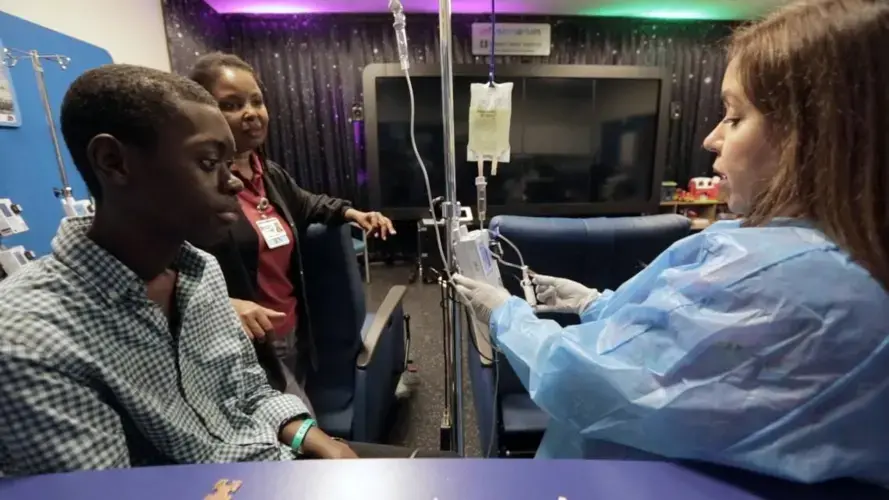
He sat down so a nurse could access the port in his chest for chemo. Covering his face with one hand, he held onto his mother with the other as the nurse counted to three and inserted the needle inside the quarter-size hole that would deliver the medication.
“We know his routine to a T,” said nurse Sahidy Aguilar. “He’s amazing.”
Pulling a jigsaw puzzle out of a toy chest, he moved to the chemo side of the room, took a seat at a high-top table and waited to be hooked up. Ten minutes later, the machine beeped and he cheerfully announced, “I’m done.”
Daghistani, his oncologist, asked in French how he was feeling — “Très bien? ” — and then watched Djonsly take a few steps. He wanted to monitor one of the side effects of the illness that has become more pronounced with chemo: numbness, known as foot-drop, that makes it hard for the teen to pick up his feet when he walks.
Months earlier, Djonsly was taken off one type of chemo because he had lost too much weight and the chemo wasn’t working. Since then, he’s been on a different, more aggressive chemotherapy. Daghistani isn’t completely sure if it will work.
“We started him on the second line of chemo and it seems that it is stabilizing his disease,” he said. “We just need to see what’s going to happen in the next few months. This type of cancer is not fast growing; it’s slow growing so that’s why it’s very hard to tell. We need time. We need to be patient, have perseverance. It’s just hard to tell his prognosis.”
Daghistani is trying to avoid using radiation, which could help attack the disease but also could lead to a secondary cancer. “We’re praying that he continues responding to chemo. Worse case scenario ... we have to use radiation. We have to keep that as our life insurance policy for now.”
So far, he said, the chemotherapy is holding off the progression of Djonsly’s disease.
“Djonsly is currently doing very well,” Daghistani said. “The plan is to treat him for one full year and reevaluate him. Optic glioma in pediatric [patients] behaves better than in adults. But in general it is unpredictable. Some patients live with their disease for a long time and some do not. In the case of Djonsly, because of the delay of diagnosis and spread of disease, the prognosis is guarded.”
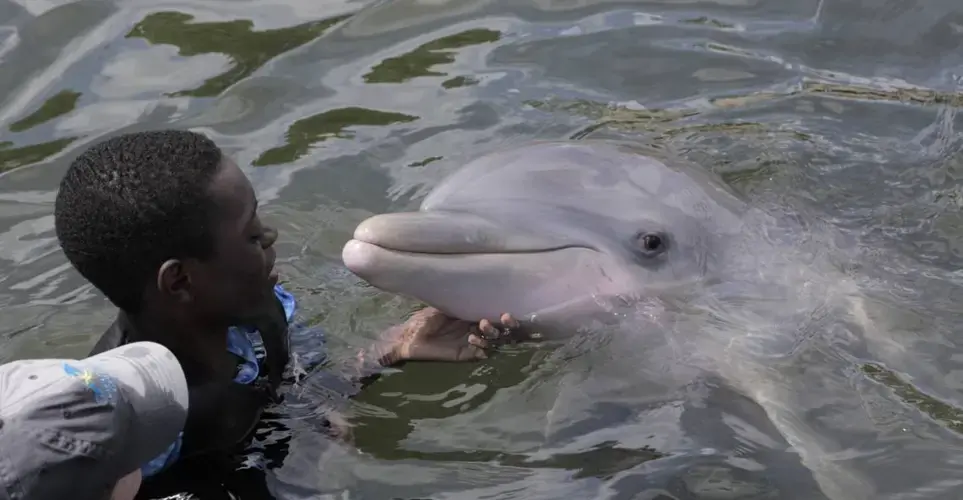
Two days after chemo, Djonsly was at Island Dolphin Care in Key Largo for a therapeutic session with dolphins for young cancer patients. Scared because he doesn’t swim, he held tightly to the instructor as she taught him hand signals to get the animal to do tricks.
It was his second big outing of the summer. In June, he had spent five days at a camp in Hollywood for kids with cancer. When he went to his next chemo appointment, his roommate from the camp, a boy named Matthew, had left him a surprise gift: an Xbox.
Linda Dwyer, a volunteer with Babcock’s charity who drives Djonsly and his mom to appointments, posted a photo of him playing the game on her Facebook page. “Our VIP is turning into an American teen,” she wrote.
He’s becoming more accustomed to the U.S. in other ways, too. With Baptist Health South Florida taking care of his medical expenses, and the Child Foundation, a Miami charity, handling housing and other costs for him and his mother, Djonsly, an only child, is learning English while being home schooled.
After the dolphin swim, he grabbed his phone, sat by the pool and did what other kids his age do in the U.S.: He shot a video of the next group swimming with the dolphins.
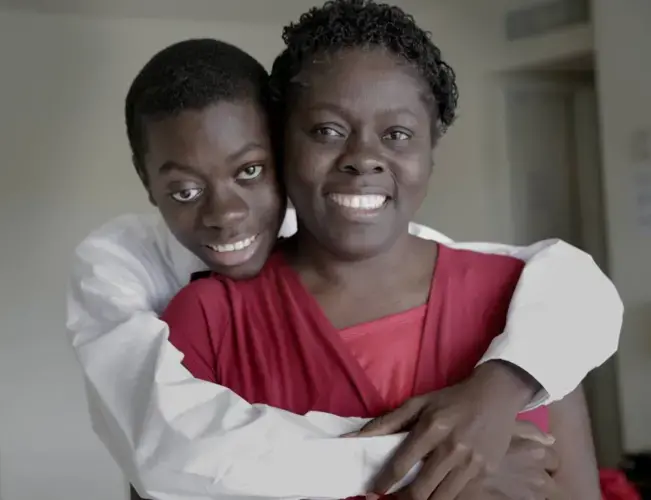
Most other days, as the chemo continues, his life consists of school, physical therapy and church, twice a week. Every eight weeks, he gets an MRI, to see how his body is responding to treatment. In Haiti, the scan would have cost an impossible $630 each time.
His mom is grateful for the normalcy of a routine for her son, even if it’s temporary.
“After God, they are the ones who have helped me,” Louis-Jean said, of the care at Baptist. “If it wasn’t for them, I would have lost my child.”
CANCER IS TABOO
The difference in cancer care between Haiti and Miami can, without exaggeration, mean life or death, said Pearson, who has come to know both boys through her work as a Baptist Health nurse and a volunteer in Haiti.
She can see Djonsly, in Miami, getting stronger with treatment.
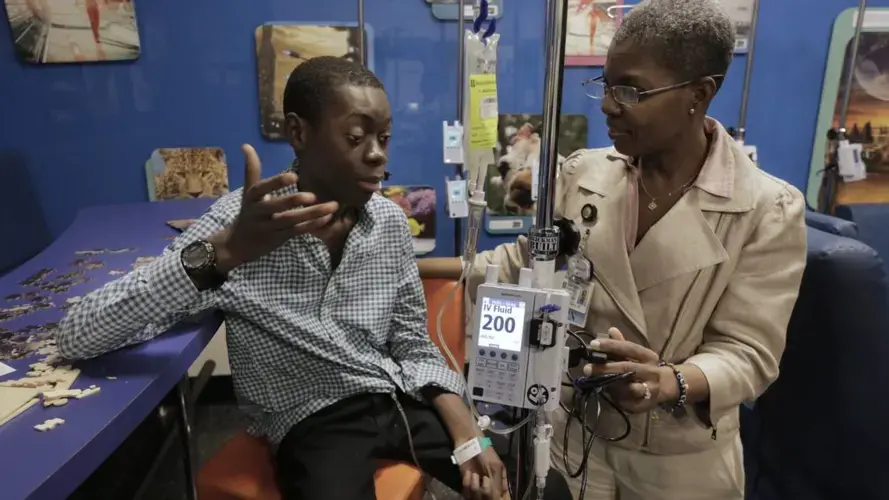
“He’s better, he’s more active, he’s happier. I see a lot of progress with him,” she said. “He’s doing a lot of things he wasn’t able to do when he first came here.”
Pearson believes that if Djooly, in Haiti, had the same access to care that Djonsly has in the U.S., his prognosis would be better.
“Djonsly has a greater chance for survival ... because of the new drugs, of the new things he could have access to, while Djooly can have access to only the minimal, the little chemo that he could receive at Mirebalais. The back and forth to Mirebalais is, like, hours on a public bus,” she said. “With Djooly, sometimes they have to wait almost a month to give him chemo because he needs two units of blood because he was so sick.”
That happened May 18 when Djooly, waiting to start the first of six planned sessions of chemo, ended up in the emergency room vomiting blood. His mother was terrified.
“When I saw that, I said in my heart, ‘God, it looks like I am going to lose the fight. ... I just finished burying his father. Now I am going to have to bury a child?’ ” Altidor recounted.
He eventually made it through and began chemo. But getting treated remained a struggle.
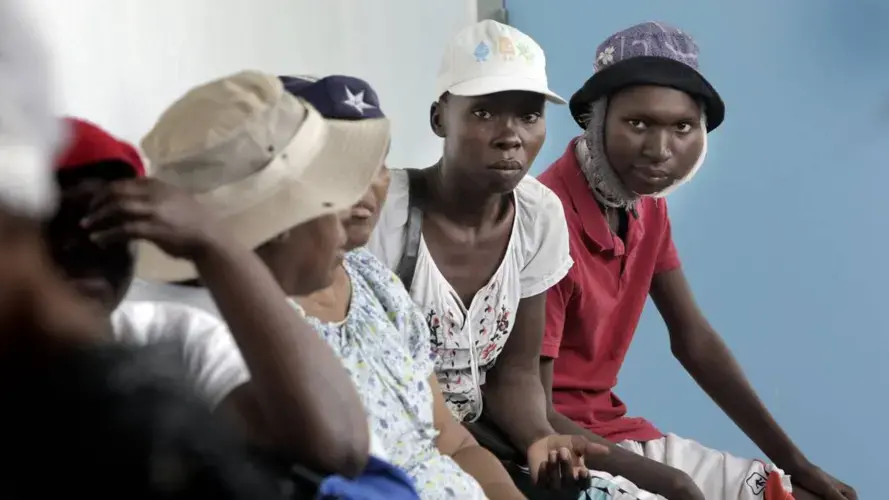
In early August, as cancer patients filed into the treatment room at the Mirebalais hospital, Djooly sat quietly on a wooden bench, trying to make himself small. He had bent his left leg and pulled it close to his chest, tucking his head to hide the tumor. He wore a purple and pink hat pulled low and a soiled bandage covered his jaw.
“There are times I would say, ‘Djooly... when you are sick and you keep covering yourself, sleeping inside, it’s not good for you. You have to go outside and get some air,” Altidor said.
But when he did go outside, she said, he would only go “holding a towel in his hand to cover his illness so people don’t see it.“
As she waited for the nurses to tell her whether Djooly was strong enough to be treated that day, Altidor opened a small backpack and pulled out a cup. Since Djooly’s cancer, she never leaves home without a cup, plate and spoon because a relative once gave a thirsty Djooly water in a paper cup, rather than using her own china.
Cancer is a taboo subject in Haiti. People often hide the disease, trying to avoid the stigma, but it persists. Djooly and his mother have felt it repeatedly.
In school, when his tumor became large enough to disfigure him, Djooly was refused entry because the director believed he would infect other students.
“They told me there was no need for me to come,” Djooly said. “They kicked me out.”
School, he said, meant everything to him. It was the one place where he felt comfortable, where he could still envision a bright future.
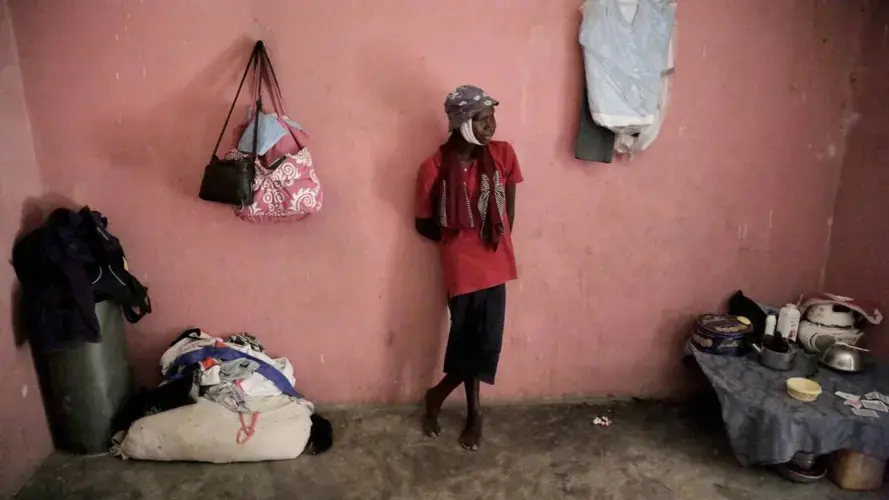
“It makes me feel bad when I see that I can’t go and my uniform is ready,” he said, his voice so low he was almost whispering. “If I were not sick, I would have gone.”
Altidor said she has sometimes seen him staring at his uniform hanging in their home and speaking to it: “Uniform, stay hanging there, OK? I might be sick, I might be in bed, but you stay where you’re at.”
Before her husband’s death, Altidor survived on his construction earnings and worked as a street vendor selling washing detergent. She’s had to quit since Djooly’s illness to take care of him. Sitting outside the Mirebalais cancer treatment center, she wondered once again what she could have done to prevent the cancer.
It is a question that has tormented her: “How is it that he got this disease?”
Four hours after arriving at the hospital that day, Altidor learned that Djooly wouldn’t be able to receive chemo. The doctor didn’t like his white blood cell count, a nurse told her, and wanted Djooly to come back the following week.
Altidor was crushed. She tried not to show it in front of Djooly.
“It’s your kid. You have no choice,” she said, and sighed as her eyes welled up with tears. “Problems.”
CHILDREN DON’T GET CANCER
On Oct. 8, Djooly — who turned 18 in September — finally had the last of his chemo sessions in Haiti and in the weeks since, the tumor has started to regrow. Altidor said doctors have raised the possibility of radiation. There is none in the country, and for a mother who couldn’t even afford to send her other four children back to school this year, the possibility is beyond her.
“I don’t have a father who is helping me. I don’t have anyone in my family who is helping me. It’s only me and God,” she said. “I don’t like to beg, or keep having to beg.”
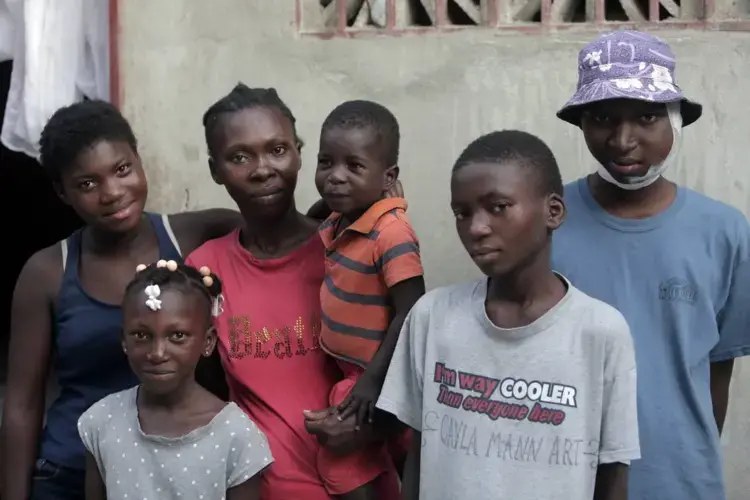
Mixter, the Wisconsin plastic surgeon who volunteers at Mirebalais, said he thinks surgery and radiation might be the best bet — if it’s feasible.
“We are talking about saving a child... in a place where we don’t have all the drugs, all the modalities that most good hospitals in the States would have,” Mixter said.
Surgery and radiation used to be treatment options for Burkitt’s lymphoma in the U.S. But in the 1980s, they were replaced with aggressive chemo. The protocol may or may not require blood and platelet transfusions, and involves hormonal therapy to help with patients’ weak immune systems and lots of hospital admissions to provide intravenous antibiotics.
“You have to look at it from the best treatment vs. what’s practical,” said Mixter. “If the chemo is not successful — and I’m not totally optimistic it’s going to be — the ability to try different drugs ... is not possible in Haiti. He may be headed for the group that is resistant.”
Mixter knows radiation in the neighboring Dominican Republic can cost $10,000 or more. He’s wondered if a crowdfunding campaign to help Djooly and other kids with cancer might be a solution.
“The ability to get him to Miami or Boston or New York or wherever for treatment is a slim possibility at best and without possibility of having pro bono care, the possibility is zero,” Mixter said.
Altidor’s living situation is not good — which means Djooly’s is rough, too. When the owners of the property where she lives are in Haiti, they occasionally cook and give Djooly food. He gives his mom and four siblings a spoonful each, which is sometimes their only meal for the day. Inside, the only piece of furniture is a twin-size bed for Djooly. Everyone else sleeps on the floor.
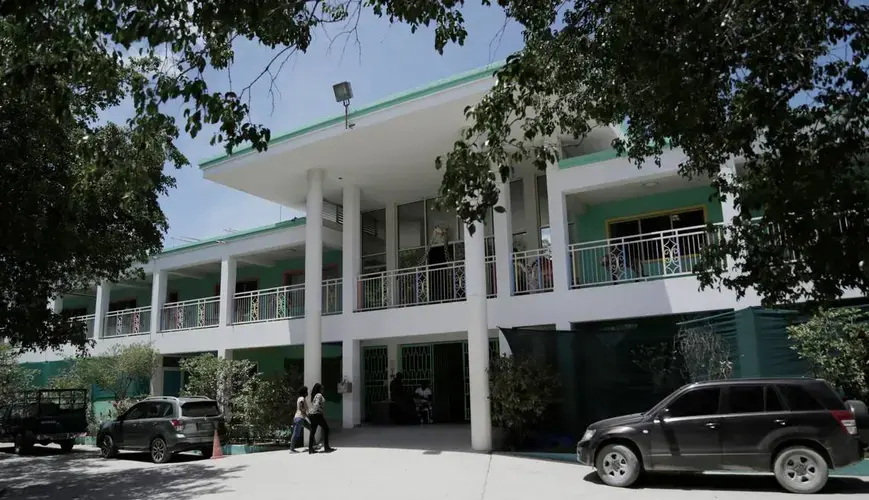
Before Djooly got into the Mirebalais cancer program, Mixter was trying to see whether the doctor who runs the pediatric oncology program at St. Damien would accept him. St. Damien sends patients to the Dominican Republic for radiation at no cost.
The hospital has a new Burkitt’s lymphoma treatment that was started by the director, Dr. Pascale Yola Gassant, with the help of St. Jude’s Research Hospital. But Djooly is too old and the chemo available there isn’t strong enough to help him.
The demand for treatment for kids with cancer in Haiti has grown, Gassant said, from two cases when she started the program in 2004 to 78 new cases last year. Her program still has just 10 beds for young cancer patients who are hospitalized.
“Everybody is saying there is an explosion of cancer,” she said. “I say, no, there isn’t any explosion of cancer. If you are reading the international literature on cancer, they tell you that 80 percent of children with cancer are living in low and middle income countries — in countries like Haiti.
“There were always children dying from cancer, they just weren’t diagnosed.”
Gassant said 90 percent of the parents who come to her with their sick children have already been to several hospitals.
Some were told by doctors that “children don’t get cancer,” she said, shaking her head. “Everyone should be educated that the disease of cancer is a public health problem.”

Education Resource
Meet the Journalists: Jacqueline Charles and José Antonio Iglesias
"If people don't know that the problem exists, then how can you even begin to find a solution?"...




